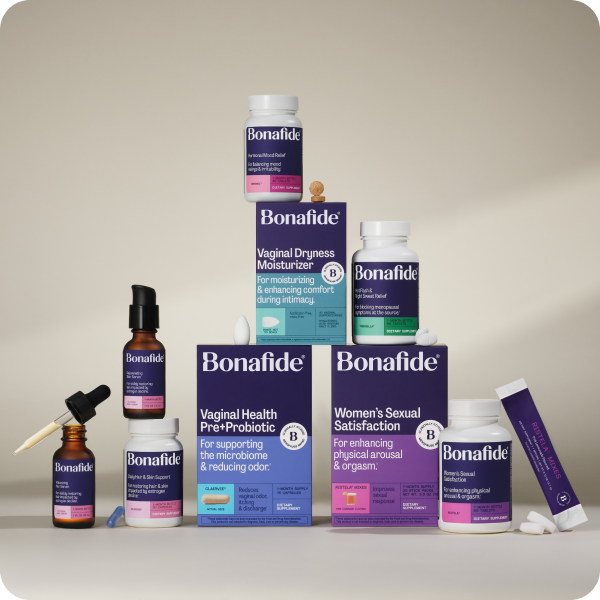When we think of perimenopause, most of us picture women in their 40s or 50s navigating hot flashes and irregular periods. But what if this transition started much earlier—like in your 30s? While it’s less common, perimenopause can begin as early as your mid to late 30s, catching many women off guard.1
If you’ve been feeling like something is “off”—whether it’s irregular periods, mood swings, or trouble sleeping—it might be time to explore whether early perimenopause symptoms could be the cause.
How Early Can You Enter Perimenopause?
Perimenopause is the natural transition phase leading up to menopause, marked by volatile estrogen levels and irregular menstrual cycles.2 While the average age for menopause is 51, perimenopause can start in your 40s or even your 30s, with about 5% of women experiencing menopause before 45, and 1% before 40—a condition known as premature menopause or “early menopause”.3
If you’re in your early 30s and noticing symptoms like missed periods, hot flashes, vaginal dryness or mood swings, it’s worth discussing with a healthcare provider if these could be early signs of perimenopause.
Diagnosing Perimenopause in Your 30s
Receiving a diagnosis of perimenopause in your 30s can be challenging for several reasons, one of which is that standard hormone testing may not tell the complete story of what may be going on in your body.
So, how reliable are standard hormone tests, like FSH and/or estradiol, for diagnosing perimenopause younger women?
FSH, or follicle-stimulating hormone, is produced in the brain and signals the growth and maturation of ovarian follicles, regulating ovulation and estrogen production within the body.4
Serum levels of FSH are menstrual cycle-dependent and are typically most accurate during days 2-3 of your monthly cycle, with day 1 being the first day of your period. During perimenopause, ovulation and menses can be quite irregular, as can FSH levels can vary considerably. While FSH can be supportive of a perimenopause diagnosis, these levels truly only represent a quick window in time; a formal diagnosis needs to be made clinically.
This means that traditional hormone tests, like FSH, are often unreliable for younger women, as levels can fluctuate significantly from cycle to cycle.5
Additionally, early perimenopause symptoms like fatigue, mood swings, and irregular periods can mimic other conditions, such as thyroid disorders, anemia, or even stress.6,7 This is why tracking your symptoms over time and working with a knowledgeable provider is crucial to spotting the early signs of perimenopause.
Emerging Tools for Diagnosis of Signs of Early Menopause for 35+
While traditional hormone tests have limitations, newer diagnostic tools are offering more accurate ways to assess ovarian function. So can any of these emerging diagnostic tools or methods that can help identify perimenopause in younger women?
Perimenopause is primarily a clinical diagnosis that takes many variables into account, including medical and menstrual history, physical exam, blood work, and possible imaging.8 Oftentimes, understanding whether symptoms are perimenopause-related also means ruling out other medical issues, including anemia or thyroid disorders.
Menstrual apps, symptom trackers, and wearables can be helpful to collect one’s personal data and establish patterns and note changes. Newer hormone tests, including AMH (anti-Müllerian hormone), may show promise in the space as well.9
These tools, combined with a thorough medical history and physical exam, can help your provider make a more accurate diagnosis.10 Therefore, all signs of early menopause at 35 need to be looked at from a wider angle to determine the complete picture.
Finding the Right Healthcare Provider for Early Signs of Perimenopause
Navigating signs of early menopause at 35 or in your early thirties often requires working with a provider who understands your unique needs. You might be wondering, what are the best ways to find a healthcare provider that is well-versed in early-onset perimenopause?
In many instances, you can rely on their OBGYN or internal medicine provider to navigate and manage all of life’s reproductive stages and hormonal health changes, including menopause. But since not all healthcare providers have interest in or have been adequately trained in midlife women’s health, you can also seek out a consultation with a Menopause Society Certified Practitioner (MSCP) for more specialized perimenopause and menopause care. These providers have extensive training and expertise in the field, including intensive training in both hormone health management and alternative management for bothersome symptoms during this time.11
Regardless of what type of physician you choose, when selecting a provider, be sure to come prepared with questions about their experience with managing early perimenopause and its symptoms, their familiarity with newer diagnostic tools, and their approach to treatment.12 If you feel dismissed or unheard, don’t hesitate to seek a second opinion. Your health is worth it.
Managing Early Perimenopause Symptoms
If you’re diagnosed with perimenopause in your 30s, there are ways to manage your symptoms and protect your long-term health:13
- Lifestyle Changes: A balanced diet, regular exercise, and stress management can help alleviate symptoms like hot flashes and mood swings.
- Hormone Therapy: For some women, Hormone Replacement Therapy (HRT) can be a game-changer, relieving symptoms and protecting bone and heart health.
- Hormone-free Options: If HRT isn’t an option, medications like antidepressants or blood pressure drugs can help manage symptoms.
Take Control of Early Perimenopause Symptoms
Experiencing early perimenopause symptoms in your 30s can feel overwhelming, but you’re not alone. By understanding the early signs of perimenopause, seeking an accurate diagnosis, and finding the right support, you can navigate this transition with confidence. Whether you’re 35 or 45, your health matters—and knowledge is your greatest tool. Track your symptoms, ask questions, and advocate for the care you deserve.
Resources
- https://www.mayoclinic.org/diseases-conditions/perimenopause/symptoms-causes/syc-20354666
- https://my.clevelandclinic.org/health/diseases/21608-perimenopause
- https://www.yalemedicine.org/news/early-and-premature-menopause
- https://medlineplus.gov/lab-tests/follicle-stimulating-hormone-fsh-levels-test/
- https://www.mayoclinic.org/diseases-conditions/menopause/diagnosis-treatment/drc-20353401
- https://www.health.harvard.edu/womens-health/perimenopause-rocky-road-to-menopause
- https://mcpress.mayoclinic.org/menopause/menopause-symptoms-it-could-be-a-copycat/
- https://www.mayoclinic.org/diseases-conditions/perimenopause/diagnosis-treatment/drc-20354671
- https://pubmed.ncbi.nlm.nih.gov/36651193/
- https://centerforhumanreprod.com/interpreting-your-levels
- https://menopause.org/professional-resources/mscp-certification
- https://menopause.org/patient-education/choosing-a-healthcare-practitioner
- https://www.mskcc.org/cancer-care/patient-education/managing-menopause-early-menopause










